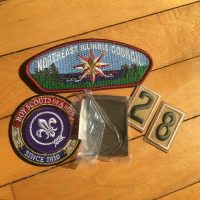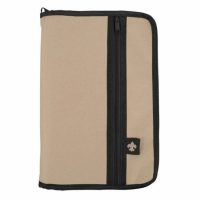iNaturalist is a great tool for scouts (or people in general) interested in learning about the plant and animal species in the world around them. Scouts are always encouraged to learn more about their natural environment with or without electronic tools, but for scouts who don't have the patience to flip through botany books, or who would like to try out an app that makes great use of technology to accelerate learning, iNaturalist is a helpful options.
With parents' permission, scouts may use iNaturalist to help them meet the rank requirements of First Class #5a (identify 10 plants). It may also be helpful for Second Class #4 (identify 10 animals), but iNaturalist is more effective in direct identification (take a picture of a plant or animal like a butterfly or bird) than in identifying other “evidence” (e.g., footprints, scat, spider-webs, feathers, molted skins, etc.).
You do NOT need to use iNaturalist to complete the identification for requirements for Second and First Class. This is completely optional. If you prefer to use guidebooks, iNaturalist also provides digital guides to several categories of flora and fauna in the Chicago area.
The Troop 28 iNaturalist Challenge: Identify 10 distinct plants or animals using the iNaturalist app. Scouts are encouraged to complete the troop iNaturalist Challenge even if they have already completed the associated rank requirements.
What is iNaturalist?
iNaturalist is a joint initiative of the California Academy of Sciences and the National Geographic Society. Amateur naturalists can contribute to by recording observations in the field, sharing these observations with the iNaturalist community, and joining in the discussion of your findings.
According to iNaturalist, every observation can contribute to biodiversity science, from the rarest butterfly to the most common backyard weed. We share your findings with scientific data repositories like the Global Biodiversity Information Facility to help scientists find and use your data. All you have to do is observe.”
While photographs can be taken and then uploaded via a computer browser, there are several advantages to using iNaturalist on a smart device in the field.
IMPORTANT! iNaturalist uses a combination of geolocation, photographs, crowd-sourced data, and person-to-person exchanges of information. You have to create an account to record observations. Parents are urged to download the apps to their own devices, and/or to work with their scouts to ensure they are able to participate safely online.
How Does the Challenge Work?
- Download the app to your smartphone or other mobile device.
- Create an account.
- Make a test observation. You can use a potted plant, pet, or tree in your backyard if you like to make sure that you understand how the app works. See below for detailed instructions.
- Pick a location. Scouts are encouraged to get outdoors. Find a new forest preserve, park, or hiking trail and take a hike! Note: the rank requirements ask scouts to identify “native plants” and “wild” animals. Finding 10 of these in heavily landscaped suburban parks and backyards may be difficult, so more than one visit may be necessary depending on the scout's choice. Read more about how iNaturalist location data is used.
- Get outside and record your observations in the field. Some of the species you find (for example, buckthorn!) may not be native species. And sometimes the same species may look different in different settings, so it's recommended that you aim for 12-15 distinct observations so you end up with 10 distinct examples. Make your best guess at identifying each of your observations; review the feedback you receive and update your identifications if necessary.
- Submit a screen capture of your completed observations. To participate in the Challenge, submit your observations to Ms. Lin to share with the rest of the troop (all submissions will be accepted, even if there are fewer than 10). And/or review with a more senior scout or adult leader to receive rank advancement credit.
Making observations
Tip: As much as possible, when taking pictures for your observations, try to make sure that your photo includes only one species. If iNaturalist isn't able to help you identify the species, try taking photos from different angles. Try a close up of just one sample, or, if it's a plant that grows in clumps or patches, try the whole clump. Try different parts (e.g., stem, flower, leaves, or the overall branch structure of an entire tree). If you are in the field with a smart device, it's easy to take photos from alternative angles — this option will not be available to you if you don't upload the photos until you return home.
Read more on the iNaturalist site.
To make observations in iNaturalist:
- Launch the app.
- Click on the Observe icon at the bottom. The first time you use the app, you may need to allow access to your device's camera and/or photo collection. Click Next. This will save the photo on your phone and capture the image.
- Adjust the location settings. If you are in a public space like a forest preserve or state park and are comfortable doing so, you are encouraged to allow the geotagging, to help create the database of species found in our area. If you are at home, you may prefer to change the Geoprivacy setting to Private to mask your location. Alternatively, there are two “in-between” options available to you: a)you can change the Geoprivacy setting to Obscured, which will prevent your exact location from being published but will still provide some location data to iNaturalist for research purposes. Or, b) you can click on the exact location/address and set the location center to a different location or zoom out to a broader radius, which will record a more generalized location. You can also use your device settings to prevent the app from geotagging entirely. Read more about the various Geoprivacy options here.
- Click on What did you see to view suggestions. You can scroll down the list of suggestions to find the best options. Some will be labeled “visually similar” or “seen nearby” or flagged as “we're pretty sure this is in [a particular] genus.” If you click on the (i) link next to suggestion that looks best to you (or if none look quite right), you will be able to “swipe” through a gallery of alternative views for some species, which will include ones with and without flowers, or different close-up/zoomed out views or parts like stems. Do your best to identify the species based on what you see.
- If you can't identify your species based on the available information, you may choose to add more observations of the same plant to give yourself (and other amateur naturalists) more information to help you identify your species.
- Once you have selected the identification that looks best to you, make any Notes, if desired (e.g., parts of the plant you couldn't get into the photo) or add additional photos of the same specimen from different angles, and when ready, click Share.
- Repeat for at least 12-15 distinct-looking specimens while you are out in the field. Some species you identify may not be native, and some that may look different may actually be the same plant. So if you can find more than 10, keep observing while you enjoy the rest of your hike!
- After your hike, in a day or so, re-launch the iNaturalist app (or log in using a browser) and you will likely find that several experienced naturalists have commented on your observations. Some may have identified species you couldn't have identified, and others may correct your entries. If you see things that make you question their identifications, you can provide additional information (for example, you may have seen something they cannot see in your photo). If you come back again, you will find many of them will respond to your additional notes or observations. Learn from others' recommendations, or provide more information to see if it will change anyone's mind.
- Take a screenshot (or more, if you have more than will fit on a screen) of your observations, and or email them to Ms. Lin) to share with the troop along with a generalized description of where you observed (at home in Glencoe, Skokie Lagoons, Somme Woods, etc.). Any identifiable usernames will be pixelated before posting to the troop website.
If you come back yet a few more days later, you will find that images that have multiple concurrent IDs have been reclassified as “Research Grade.” iNaturalist has estimated that 85% of “Research Grade” identifications are accurate.
Happy hunting!





